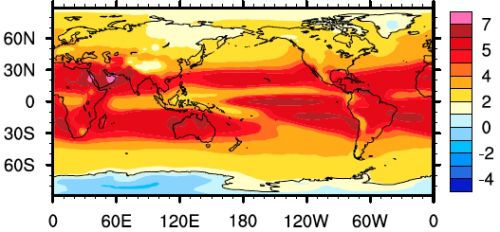
It is often quoted that every doubling of atmospheric CO2 decreases the outgoing radiation by ~3.7 W m-2. However, important questions regarding this primary forcing of climate change were not fully understood: 1) Why does the radiative forcing scale logarithmically with absorber concentration? 2) Is the forcing for every doubling really a constant number? 3) If not, what is the implication of forcing inhomogeneity? A few new papers by Huang's group have addressed these questions.
The value of the forcing strongly depends on other atmospheric variables than the forcing agent itself (concentration of CO2) and thus varies geographically. We developed a convenient diagnostic method for estimating the forcing values on a case-by-case basis [Zhang and Huang 2014].
We also find that the log dependence of the greenhouse gas forcing applies to not only broadband outgoing radiation flux but also monochromatic radiance, which means this log behavior is not only due to spectroscopic line features but also radiative transfer in the atmosphere [Huang and Bani Shahabadi 2014].
Furthermore, the forcing inhomogeneity is found to have important implications for climate change. Huang and Zhang [2014] show the enhancement of poleward energy transport during global warming is largely caused by the meridional gradient of the well-mixed greenhouse gas forcing, i.e., the inhomogeneous forcing of the homogeneous gases.
References
Huang, Y. and M.Bani Shahabadi (2014), Why logarithmic: A note on the dependence of radiative forcing on gas concentration. J. Geophys. Res. - Atmos., 119, doi:10.1002/2014JD022466.
Zhang, M. and Y. Huang (2014), Radiative forcing of quadrupling CO2, J. of Climate, 27, 2496–2508. doi: http://dx.doi.org/10.1175/JCLI-D-13-00535.1
Huang, Y. and M. Zhang (2014), The implication of radiative forcing and feedback for meridional energy transport, Geophys. Res. Lett., doi: 10.1002/2013GL059079.